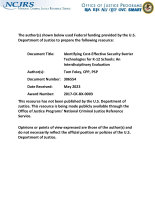Corrections security
Evaluation of Objective Prison Classification Systems
The Impacts of School Security Equipment on Students and Schools
Quasi-experimental evaluation of contraband interdiction technologies
Redesigning Life in U.S. Prisons
The prison system in the U.S. typically places a heavy emphasis on security, control, and punishment, and this foundation can create an adversarial culture within correctional facilities — incarcerated individuals versus correctional staff. But what if that culture could change? What would it look like? How would it impact not only incarcerated individuals but also correctional officers and other staff?
Countering the Emerging Drone Threat to Correctional Security
Best Practices for Improving the Use of Criminal Justice Risk Assessments: Insights from the National Institute of Justice’s 2021 Recidivism Forecasting Challenge Winners Symposium
Examining the Impacts of Body-Worn Cameras on Correctional Culture, Climate, and the Well-Being of Staff and Incarcerated Persons
A Randomized Controlled Trial of the Impact of Body-Worn Cameras in the Loudoun County, VA, Adult Detention Center
Identifying Cost-Effective Security Barrier Technologies for K-12 Schools: An Interdisciplinary Evaluation
Emerging Relevance of Neuroscience in Corrections
Printed multilayer microtaggants with phase change nanoparticles for enhanced labeling security
Desistance From Crime: Implications for Research, Policy, and Practice
Most scholars would agree that desistance from crime – the process of ceasing engagement in criminal activities – is normative. However, there is variability in the literature regarding the definition and measurement of desistance, the signals of desistance, the age at which desistance begins, and the underlying mechanisms that lead to desistance. Even with considerable advances in the theoretical understanding of desistance from crime, there remain critical gaps between research and the application of that research to practice.
See the YouTube Terms of Service and Google Privacy Policy
Physical Safety and Preparedness - Breakout Session, NIJ Virtual Conference on School Safety
On February 16-18, 2021, the National Institute of Justice hosted the Virtual Conference on School Safety: Bridging Research to Practice to Safeguard Our Schools. This video includes the following presentations:
See the YouTube Terms of Service and Google Privacy Policy
Using Virtual Reality To Prepare Inmates for Release
"The Other Way" Program Evaluation
Impact of Job Characteristics on Correctional Staff Members
No Shortcuts to Successful Reentry: The Failings of Project Greenlight
Cell Phones in Prison
Criminals are using cell phones illegally in prisons and jails to conduct their business and intimidate witnesses. Although technology solutions to this problem are available, they can create new challenges, such as legal and implementation issues associated with cell phone use in correctional facilities. Panelists will discuss various aspects to consider from how prisoners use cell phones, to day-to-day and operational aspects, to legal and regulatory concerns.
What Works in Reentry
See the YouTube Terms of Service and Google Privacy Policy





